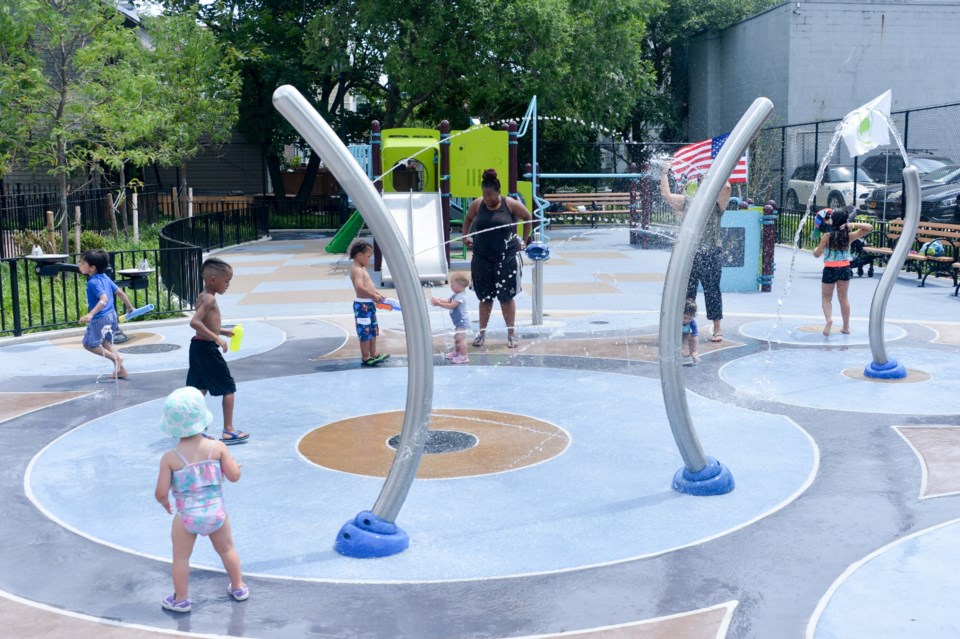Are we beating the heat or is the heat beating us? Although the NYC Department of Parks and Recreation warns locals about summer heat, our children pay the price from inadequate cooling measures. Adaptations of park and playground infrastructure are crucial to protect communities against soaring temperatures caused by climate change that often result in heat-related health issues.
I spent entire summers at the park and playground as a child, running around with friends while our older siblings played basketball at the courts nearby. Growing up in a majority immigrant, working class neighborhood of Greenpoint, Brooklyn, these public spaces were reliable options for children who could not attend expensive or exclusive summer programs. Walking through the Vincent V. Abate playground last summer, I saw black rubber swings and metal slides reflecting the blinding sun as temperatures climbed into the 90s. Children ran through spray showers, filled water balloons at drinking fountains and crowded icy vendors. Without these water features, I doubt the playground would have been as full of life.
According to the American Academy of Pediatrics, temperatures above 89ºF could cause health risks for children, including heat exhaustion, heat stroke and dehydration. Children under 5-years-old are at particular risk. In 2024, the city experienced 21 days above 89ºF. The risk of injury associated with heat differs across neighborhoods, with a majority of Black communities in central Brooklyn showing the highest vulnerability to heat and heat-associated death rates. What improvements could be made in these high-risk neighborhoods to decrease heat-related health issues?
The city Parks Department releases guidelines for the safe use of playgrounds during the summer. Children should wear sunscreen, avoid hot surfaces or find cooling alternatives. In 2023, the Practice Safe Skin program provided free sunscreen at city beaches. The program led to over 145,000 sunscreen applications and informed beachgoers about protecting themselves against the sun’s dangerous ultraviolet rays.
Installing free sunscreen dispensers and caregiver education booths in central Brooklyn could be beneficial for Black communities. Since melanin protects darker skin from UV rays and sunburns, many people assume there is less or no need for sunscreen. However, this barrier only protects the skin to an extent. The Skin Cancer Foundation notes, “if you have skin, you can get skin cancers,” and it is the most common cancer in the U.S. Although people of color experience skin cancers less often, when they are found, the cancers are usually at a later, more dangerous stage. These cancers are harder to identify and the five-year melanoma survival rate for Black patients is 71% compared to 94% for white patients.
Hot surfaces such as metal slides, handrails and rubber walkways could cause serious skin contact burn injuries. Painting over bare metal or building plastic structures is still not the safest for children to play on. The Centers for Disease Control and Prevention found that shade structures provide UV protection. The American Academy of Dermatologists has been advocating to build more shade structures across the U.S., including over playgrounds, picnic areas and sports courts. Although shade does not decrease the temperature, being out of the sun’s UV rays would decrease the risk of heat injury and skin damage.
For those who prefer indoor activities or who may not have water features in heat-vulnerable neighborhoods, NYC Cool Options are available. However, instead of recreational spaces, most of the places listed are libraries, or senior centers allowing only older adults. Only two of the 12 listed Brooklyn community centers, in Crown Heights and Brownsville, serve central Brooklyn. City recreation centers were not listed at all. Implementing more programs for free indoor activities and informative websites would increase awareness of the options accessible to children in heat-vulnerable locations throughout Brooklyn.
Although we cannot stop the sun from shining, we can better protect our communities from its harmful heat and UV-rays. By advocating for increased funding to the Parks Department, protection measures that are proven to be effective could be implemented so that our public spaces are safer for children and adults.
Climate change is our reality. By adapting now, we can ensure better health outcomes for our communities in the future.
Barbara Krawczuk, a Brooklyn resident, is a public health graduate student at SUNY Downstate Health Sciences University.




